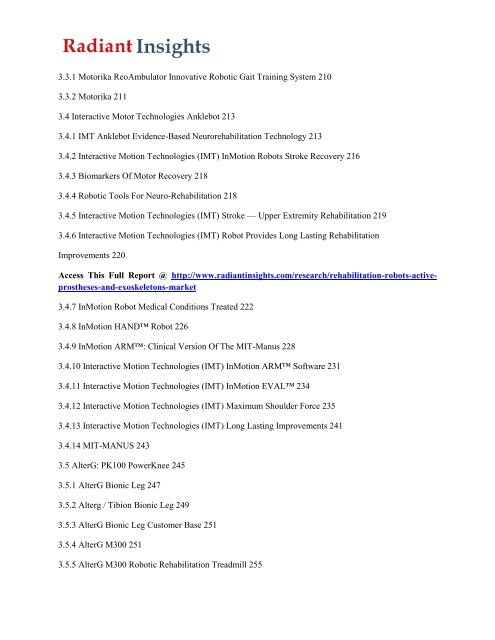Rehabilitation Robots Market Share, Size, Growth, Trend and Forecasts Report 2015 to 2021: Radiant Insights, Inc
WinterGreen Research announces that it has published a new study Rehabilitation Robots: Market Shares, Strategy, and Forecasts, Worldwide, 2014 to 2020. The 2015 study has 659 pages, 266 tables and figures. Worldwide markets are poised to achieve significant growth as the rehabilitation robots, active prostheses, and exoskeletons are used inside rehabilitation treatment centers and sports facilities providing rehabilitation for all patients with injuries or physical dysfunction. Access This Full Report @ http://www.radiantinsights.com/research/rehabilitation-robots-active-prostheses-and-exoskeletons-market Relearning of lost functions in a patient depends on stimulation of desire to conquer the disability. The rehabilitation robots can show patients progress and keep the progress occurring, encouraging patients to work on getting healthier. Independent functioning of patients depends on intensity of treatment, task-specific exercises, active initiation of movements and motivation and feedback. Rehabilitation robots can assist with these tasks in multiple ways. Creating a gaming aspect to the rehabilitation process has brought a significant improvement in systems. As patients get stronger and more coordinated, a therapist can program the robot to let them bear more weight and move more freely in different directions, walking, kicking a ball, or even lunging to the side to catch one. The robot can follow the patient’s lead as effortlessly as a ballroom dancer, its presence nearly undetectable until it senses the patient starting to drop and quickly stops a fall. In the later stages of physical therapy, the robot can nudge patients off balance to help them learn to recover.
WinterGreen Research announces that it has published a new study Rehabilitation Robots: Market Shares, Strategy, and Forecasts, Worldwide, 2014 to 2020. The 2015 study has 659 pages, 266 tables and figures. Worldwide markets are poised to achieve significant growth as the rehabilitation robots, active prostheses, and exoskeletons are used inside rehabilitation treatment centers and sports facilities providing rehabilitation for all patients with injuries or physical dysfunction.
Access This Full Report @ http://www.radiantinsights.com/research/rehabilitation-robots-active-prostheses-and-exoskeletons-market
Relearning of lost functions in a patient depends on stimulation of desire to conquer the disability. The rehabilitation robots can show patients progress and keep the progress occurring, encouraging patients to work on getting healthier. Independent functioning of patients depends on intensity of treatment, task-specific exercises, active initiation of movements and motivation and feedback. Rehabilitation robots can assist with these tasks in multiple ways. Creating a gaming aspect to the rehabilitation process has brought a significant improvement in systems.
As patients get stronger and more coordinated, a therapist can program the robot to let them bear more weight and move more freely in different directions, walking, kicking a ball, or even lunging to the side to catch one. The robot can follow the patient’s lead as effortlessly as a ballroom dancer, its presence nearly undetectable until it senses the patient starting to drop and quickly stops a fall. In the later stages of physical therapy, the robot can nudge patients off balance to help them learn to recover.
Create successful ePaper yourself
Turn your PDF publications into a flip-book with our unique Google optimized e-Paper software.
3.3.1 Mo<strong>to</strong>rika ReoAmbula<strong>to</strong>r Innovative Robotic Gait Training System 210<br />
3.3.2 Mo<strong>to</strong>rika 211<br />
3.4 Interactive Mo<strong>to</strong>r Technologies Anklebot 213<br />
3.4.1 IMT Anklebot Evidence-Based Neurorehabilitation Technology 213<br />
3.4.2 Interactive Motion Technologies (IMT) InMotion <strong>Robots</strong> Stroke Recovery 216<br />
3.4.3 Biomarkers Of Mo<strong>to</strong>r Recovery 218<br />
3.4.4 Robotic Tools For Neuro-<strong>Rehabilitation</strong> 218<br />
3.4.5 Interactive Motion Technologies (IMT) Stroke — Upper Extremity <strong>Rehabilitation</strong> 219<br />
3.4.6 Interactive Motion Technologies (IMT) Robot Provides Long Lasting <strong>Rehabilitation</strong><br />
Improvements 220<br />
Access This Full <strong>Report</strong> @ http://www.radiantinsights.com/research/rehabilitation-robots-activeprostheses-<strong>and</strong>-exoskele<strong>to</strong>ns-market<br />
3.4.7 InMotion Robot Medical Conditions Treated 222<br />
3.4.8 InMotion HAND Robot 226<br />
3.4.9 InMotion ARM: Clinical Version Of The MIT-Manus 228<br />
3.4.10 Interactive Motion Technologies (IMT) InMotion ARM Software 231<br />
3.4.11 Interactive Motion Technologies (IMT) InMotion EVAL 234<br />
3.4.12 Interactive Motion Technologies (IMT) Maximum Shoulder Force 235<br />
3.4.13 Interactive Motion Technologies (IMT) Long Lasting Improvements 241<br />
3.4.14 MIT-MANUS 243<br />
3.5 AlterG: PK100 PowerKnee 245<br />
3.5.1 AlterG Bionic Leg 247<br />
3.5.2 Alterg / Tibion Bionic Leg 249<br />
3.5.3 AlterG Bionic Leg Cus<strong>to</strong>mer Base 251<br />
3.5.4 AlterG M300 251<br />
3.5.5 AlterG M300 Robotic <strong>Rehabilitation</strong> Treadmill 255


















